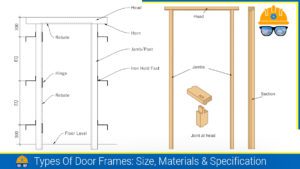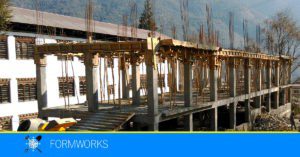There is an enormous number of infill materials for building structures. However, there are very few types of infill materials or blocks that can withstand very high temperatures and extreme conditions. In this article, we will see about “Refractory Bricks” with the property of withstanding high temperature and extreme conditions.
What are Refractory Bricks?
Refractory bricks are those blocks which are ceramic bricks that are capable of withstanding very high temperatures (above 1580°C) and resistance to chemical reactions on heating without softening. This type of brick is also called Fire brick. It can also stand the thermal shock and rough usage which result in minimal expansion and contraction.
These bricks have low electric conductivity and provide good thermal insulation. Depending upon the chemical properties of refractory bricks, they are classified into acidic, basic and neutral categories.
- Acidic refractor materials are fireclay, quartzite and silica.
- Basic refractory materials are dolomite and magnesia.
- Neutral refractory materials are bauxite, carbon and forsterite.
Chemical Composition of Refractory Bricks
Fireclay is associated with the coal seams and is a very good raw material for acidic refractory bricks. Fireclay which is suitable for fire bricks is
- 50% to 75% of silica-both free and soluble in acid
- 10% to 20% of alumina
- 2% to 2,5% of mine, magnesia, iron oxide
- alkalis (soda, potash or both) less than or equal to 1.5%
The Fireclay bricks have the same manufacturing process as other ordinary bricks. Good fireclay bricks should not show signs of softening or fusion when subjected to high temperatures up to 1500°C. The compressive strength of these types of bricks varies from 2000 to 2200 kg/cm2 and absorption varies from 5 to 10%. The fire brick may be the acidic, basic and neutral type which are used for acidic lining, basic lining and neutral lining respectively.
Due to high fire resistance, they are used in the internal lining of furnaces, chimneys, ovens, kilns, fireplaces, etc…
Also read: Types of Bricks Used in Building Construction | 6 Types of Bricks
Types of Refractory Bricks
According to the material used for manufacturing the refractory bricks, they are as following types:
Acidic Refractor Bricks
The chemical composition of the acidic bricks has silica, lime, ganister and clay. Silica brick has silica of 95-97% of silica and 1-2% of lime with very minimal impurities. Ganister bricks are composed of 98% hard-coloured stone known as ganister with 10% clay, and 2% lime.
Some of these types of brick are Ordinary Fire Brick, Silica Bricks, and Ganister Bricks. These are generally used in lining furnaces having siliceous & acidic slag steel industry and coke ovens.
Basic Refractor Bricks
Such types of bricks are manufactured from magnesia, dolomite, bauxite, etc. Magnesite Bricks, Dolomite Bricks, and Bauxite Bricks are some of the types of basic refractory bricks. Magnesia bricks consist of magnesium 85% magnesium, 25% calcium oxide and silica up to 5.5%. Bauxite bricks are made of 85% of aluminium oxide and up to 20% clay is added to them.
Basic refractor bricks are highly resistant to corrosion and are used for lining furnaces having basic slag.
Also, read: 10 Types of Stones Used for Construction Works
Neutral Refractor Bricks
Chromium ore, iron oxide and bauxite are used for manufacturing neutral refractor bricks. Chromium bricks are produced by mixing 50% of chrome, 30% of Iron oxide, and 20% of Bauxite. Apart from Chromite Bricks, some of the neutral bricks are Chrome Magnesite Bricks, Spinal Bricks, and Forsterite Bricks
The neutral refractory bricks are used in places where acidic and basic linings are to be separated.
Silica Bricks
The bricks are made of 95% to 97% of quartzite or sandstone and 1% to 2% of lime. On heating, calcium silicate glass is formed. The fine grain of quartzite is crushed in a roller and mixed in a mile with lime to form a paste. Then the mixture is allowed to dry and moulded under heavy pressure. The same is burned at high temperatures. The finished product can withstand very high temperatures above 2000°C and it is suitable for exposure to acid.
Magnesia Bricks
Magnesia bricks or Basic bricks are made for magnesite and are good for the basic lining. Used in Blast furnaces, basic open hearth furnaces, etc… These bricks are more refractory than other types of bricks.
Also, read: Stabilized Mud Block: Properties, Advantages & Usage
FAQs:
Q: What are refractory bricks?
Answer: Refractory bricks are a type of ceramic material designed to withstand high temperatures and harsh conditions. They are used to line furnaces, kilns, and other high-temperature processing equipment.
Q: Where are acidic refractor bricks used?
Answer: Acidic refractor bricks are generally used in lining furnaces having siliceous & acidic slag steel industry and coke ovens.
Q: How many types of refractory bricks are there?
Answer. Largely, refractory bricks are classified into three categories as
1. Basic Refractor Bricks
2. Acidic Refractor Bricks
3. Neutral Refractor Bricks
Q: What materials are used to make refractory bricks?
Answer: Refractory bricks can be made from a variety of materials, including clay, silica, alumina, magnesia, zirconia, and chrome.
References:
- Fire brick. (2022, August 15). In Wikipedia. https://en.wikipedia.org/wiki/Fire_brick
- Refractory Brick (2022, June 15). Corrosionpedia. https://www.corrosionpedia.com/definition/6647/refractory-brick
- Mason, T. O. (2016, February 10). refractory. Encyclopedia Britannica. https://www.britannica.com/technology/refractory
- A. Sadanandam (2019, January 28). Fire brick. The Constructor. https://theconstructor.org/building/fire-bricks-properties-types-uses/29377/
![]()







